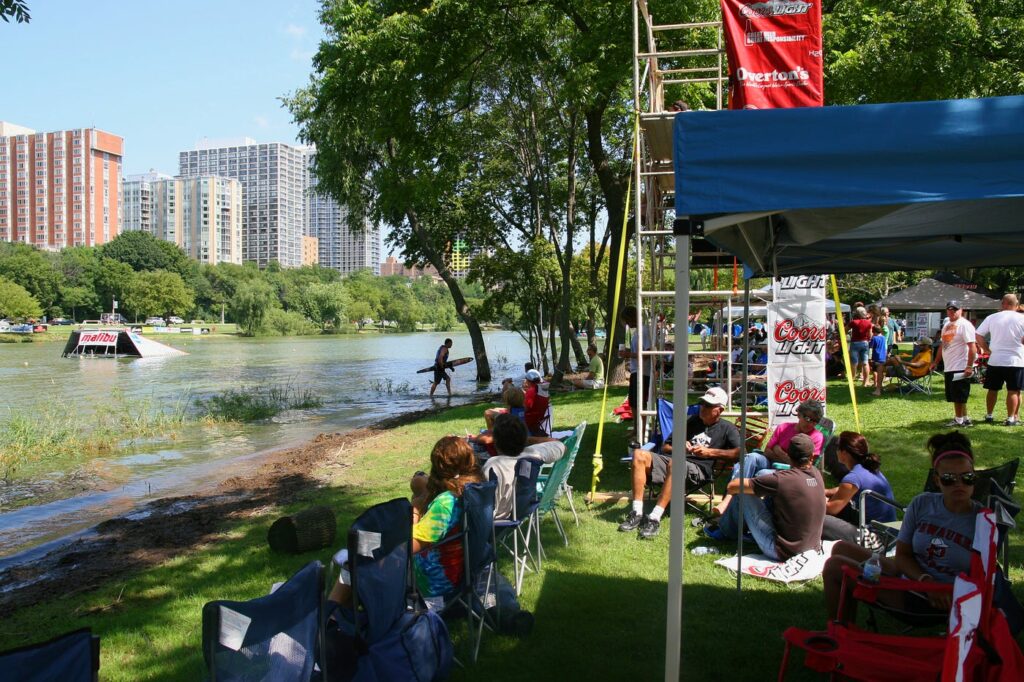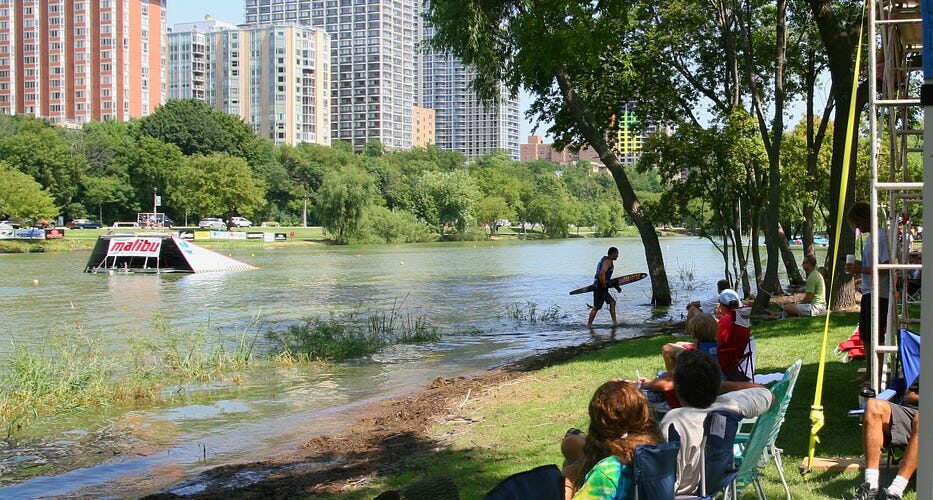The greatest shows in skiing.
On the lake and off, a new way of hosting water ski events is changing the way a pro ski event comes to life.

The Malibu Open in Veterans Park, Milwaukee (image: Joel Hughes)
By Josh Sampiero
Waterski Magazine
July-August, 2012
It sounds simple. Throw out some buoys, gas up the boat, invite some hotshot skiers, and bam, you’ve got a world class event. Easy, right? “Ha!” exclaims Dana Reed, organizer of the Malibu Open. “People have no idea the manpower that goes into putting on a water ski event. It’s a lot of hard work!” Reed should know. Over the past decade, he’s put on nearly 50 amateur and professional water ski events.
The most important lesson he’s learned? Forget what the lake looks like, and start looking at what’s around it. “If I can’t see skyscrapers within a quarter mile of the event venue, I’m not interested.” This summer, Reed’s pet project, the Malibu Open in Milwaukee, Wisconsin, and a groundbreaking event in Orlando called Soaked! Are poised to get the world of professional water skiing – and hopefully a whole lot of new fans – pretty wet.
Competitive Evolution
From competitive water skiing’s glory days until just a few short years ago, the format of competition remained fairly static, with little thought given to how to make events appeal to nonwater-skiing spectators, Reed says. “At the Malibu Open, I get asked 100 times a day how the event is scored,” he says. A few nontraditional formats have emerged to combat this, including head-to-head skiing, or elimination rounds that nonskier spectators can follow, Like Marcus Brown’s Last Man Standing contest held at BoardStock in 2007. After narrowing down the field to six skiers, the finalists all skied one pass at a time, shortening the line after each round. Skiers who missed were eliminated, and the rounds continued until only one competitor remained. “Because there was one guy after another at the same pass [the spectators] knew who won,” Brown explains. “They knew who got the furthest because they just saw everybody try 39 within a two-minute time frame … it happens quick.”
Case Study: The Malibu Open
Hard-to-understand formats weren’t the only thing holding pro skiing back. The inclination had been to hold events at private or hard-to-reach lakes. They may have offered pristine water skiing conditions, but very little in terms of visibility. But in 2011, the Malibu Open put pro-level water skiing in front of 13,000 spectators at Milwaukee’s Veteran’s Park Lagoon, which features a highly trafficked promenade, just a short distance from downtown.
Securing such a venue isn’t easy. He has to pay the paddleboat business loss of income for two days, on top of what it costs him to bring in 25 vendors, rent a 15-foot JumboTron, and get 150 posters and banners hung up in 24 hours. But it’s worth it. “I have two goals,” says 56-year-old Reed, who has been water skiing since he was 20. “To get the athletes as much money as I can, and to put as many spectators as possible on the shore for the sponsors. It’s all about putting our sport in front of people and making it grow.” It’s pretty had to argue, considering the success he’s had. This year, Reed hopes to see 15,000 or more visitors over the two-day period.
Soaking up $100,000
The Malibu Open isn’t the only event that’s generating buzz this summer. Over Surf Expo weekend in Orlando, we’ll see the debut of a new event called Soaked. Put together by former pro water skier Mike Morgan and attorney/water ski buff Steve Garcia (both of whom have children who will be competing in the event) and promoted by Australian-born Paul Lovett, Soaked is pulling out all stops and creating an absolute spectacle, right on downtown Orlando’s Lake Eola. The lake hasn’t seen a water ski event since the ‘80s.
Not only will there be pro-level slalom and jumping happening in the afternoon and at night, but there will be three stages with live band, a vert ramp with professional skateboarders, and a muscle-car and custom-motorcycle show, while local graffiti artists on the premises ink up original work. Sounds more like a party, I tell Lovett. He laughs. “When Freddy’s jumping and Ryan’s jumping, it’s awesome. When the boat’s just doing lap after lap, it’s boring. I have to think of what I can do to make this interesting for the spectator. And after 30 years of promoting events, I’m not just putting my toe in the water,” he says. “I’m diving in.” Why? It’s simple. He believes in water skiing. “We’re in a sport that’s ready to explode. Someone just needs to kick it in the ass again!” How big of a kick does it need? A $100,000 kick – one of the largest prize purses ever offered at a ski event.
The Next Show
So, is all this effort paying off? Will new formats, higher-profile venues and more people in the stands pay off in getting more water skiers on the water and increasing the visibility of the sport on the national scale? Unfortunately, there’s no instant answer to that question. We’ll have to wait and see. But for Dana Reed, what’s going to happen next is obvious. After two years of success with the Malibu Open, he’s looking at other locations, such as Denver, Colorado and Dallas, Texas. The only requirement? “Skyscrapers!” Reed exclaims. Of course.
This article originally appeared in the July-August 2012 edition of Waterski Magazine.

